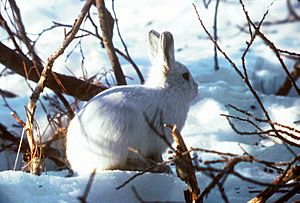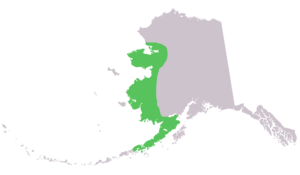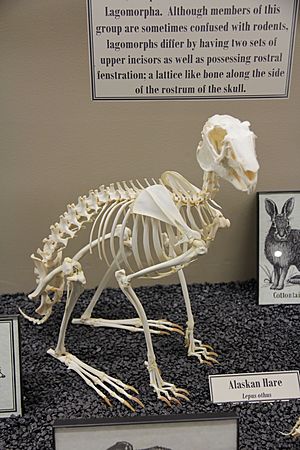Alaskan hare facts for kids
Quick facts for kids Alaskan hare |
|
|---|---|
 |
|
| Conservation status | |
| Scientific classification | |
| Genus: |
Lepus
|
| Species: |
othus
|
 |
|

The Alaskan hare (Lepus othus), also called the tundra hare, is a type of mammal that belongs to the rabbit and hare family, Leporidae. These hares live in the wide-open tundra lands of western Alaska and the Alaska Peninsula in the United States. Unlike rabbits, they don't dig burrows.
For most of the year, Alaskan hares live alone. They only gather in groups during their mating season. They usually have one litter of young each year. Their main predators include large birds of prey, polar bears, and even humans who hunt them.
Contents
Meet the Alaskan Hare
The Alaskan hare is one of the biggest types of hares in the world. It is sometimes known as the tundra hare because of where it lives. This hare is one of two kinds of hares that naturally live in Alaska. The other is the more common snowshoe hare.
How Big Are Alaskan Hares?
Both male and female adult Alaskan hares usually measure between 50 and 70 centimeters (about 20 to 28 inches) long. Their tail can add another 8 centimeters (about 3 inches) to their length. Their back feet are about 20 centimeters (8 inches) long. These long feet help them move easily across snowy ground. They can also use their strong feet to defend themselves from predators.
Alaskan hares weigh from 2.9 to 7.2 kilograms (about 6.4 to 15.9 pounds). On average, they weigh about 4.8 kilograms (10.6 pounds). This makes them one of the largest animals in their group, similar in size to the brown hare and Arctic hare.
Special Ears for Cold Weather
The ears of an Alaskan hare are quite short compared to most other hares. They have evolved shorter ears to help them stay warm during the cold winter months. A hare's ears are important for controlling its body temperature. Having small ears helps the Alaskan hare avoid losing too much heat in its chilly home.
Changing Fur Coats
In the summer, Alaskan hares have brown fur on their backs and white fur on their bellies. When winter arrives, they shed their brown summer coat. Their fur turns completely white, except for the tips of their ears, which stay black. This white fur helps them blend in with the snow.
Life of an Alaskan Hare
Alaskan hares are mostly solitary animals. This means they prefer to live alone. They usually only come together in groups during the mating season, which happens in April and May.
Hare Babies: Leverets
Female hares typically have one litter of young each year. This usually happens in June or July. A litter can have anywhere from four to eight baby hares, called leverets. These leverets are born ready for action! They have a full coat of fur and their eyes are open shortly after birth.
Staying Healthy
Hares can sometimes carry a bacterial disease called Tularemia. This disease can be passed to pets and even humans. It can cause animals and people to feel sick.
Alaskan Hare Family Tree
The Alaskan hare is closely related to two other types of hares. One is the Arctic hare (Lepus arcticus), which lives in northern Canada and Greenland. The other is the mountain hare (Lepus timidus), found across northern Europe and Asia. The Alaskan hare lives far away from these relatives.
Where Alaskan Hares Live and What They Eat
Alaskan hares do not dig underground burrows like rabbits. Instead, they make their nests in open areas. They often choose places in the high tundra or in rocky or brushy spots. These locations offer good camouflage and protection from animals that might try to hunt them.
Their Home Range
You can find Alaskan hares in western and southwestern Alaska. This includes the area known as the Alaska Peninsula.
What's on the Menu?
Alaskan hares are herbivores, meaning they only eat plants. They munch on a variety of leaves and fruits. They usually look for food during dawn (early morning) and dusk (early evening). In the summer, they eat green plants. In the winter, when green plants are scarce, they switch to eating bark and twigs.
Who Hunts the Hare?
Many animals hunt Alaskan hares. These predators include foxes, polar bears, wolverines, weasels, and birds of prey like eagles and owls. While humans don't often hunt them for food, Alaskan hares are sometimes trapped for their fur. Their fur is used to line shoes and robes in Alaska.
See also
 In Spanish: Liebre de Alaska para niños
In Spanish: Liebre de Alaska para niños


